Written by Anneri Fourie | Marketing Executive
Workplace safety is paramount for any organisation. From natural disasters to cybersecurity threats, organisations face a vast variety of potential crises that can disrupt operations and endanger employees. This is where crisis management software comes into play. By providing real-time communication, streamlined incident reporting, and comprehensive emergency plans, crisis management software is a crucial tool for safeguarding your workplace.
In this blog, we’ll explore how implementing such software can enhance workplace safety, prevent incidents, and provide a structured response to emergencies.
The Role of Crisis Management Software in the Workplace
Real-Time Communication and Alerts
Effective communication during a crisis is critical. Crisis management software facilitates real-time communication between all stakeholders, ensuring that everyone is informed and can act swiftly. This software allows for instant notifications through various channels such as SMS, phone calls, email, and push notifications, ensuring that no one is left out of the loop.
By providing a centralised platform for communication, crisis management software ensures that accurate information is disseminated quickly, reducing the likelihood of misinformation and panic. This real-time communication capability is particularly vital during emergencies where every second counts.
Streamlined Incident Reporting
Prompt and accurate incident reporting is essential for effective crisis management. Crisis management software provides a streamlined process for reporting incidents, allowing employees to quickly log details of any issues they encounter. This immediate reporting can help identify potential hazards before they escalate into a full-blown crisis.
Additionally, the software can generate detailed reports and analytics, offering insights into patterns and recurring issues. This data-driven approach enables organisations to proactively address underlying problems and implement preventive measures, ultimately enhancing workplace safety.
Comprehensive Emergency Plans
One of the standout features of crisis management software is its ability to store and manage customisable emergency response plans. These plans can be tailored to specific scenarios, ensuring that your organisation is prepared for a wide range of emergencies, from natural disasters to security breaches.
By having detailed, easily accessible plans, employees can quickly understand their roles and responsibilities during a crisis. This clarity helps reduce confusion and ensures a coordinated response, minimising the impact of the incident on both personnel and operations.
Training and Drills
Preparation is key to effective crisis management. Crisis management software often includes tools for conducting training sessions and drills. These simulations help employees familiarise themselves with emergency procedures and practise their response in a controlled environment.
Regular training and drills ensure that employees remain vigilant and confident in their ability to handle crises. This proactive approach not only enhances workplace safety, but also fosters a culture of preparedness within the organisation.
Identifying and Assessing Risks
Crisis management software is equipped with tools to identify and assess potential risks. By conducting thorough risk assessments, organisations can pinpoint vulnerabilities and develop strategies to mitigate them. This proactive approach helps in preventing incidents before they occur.
Risk assessments involve evaluating various factors such as the likelihood of an event occurring and its potential impact. By leveraging the analytical capabilities of crisis management software, organisations can prioritise risks and allocate resources effectively to address the most critical threats.
Implementing Preventive Measures
Once risks have been identified, the next step is to implement preventive measures. Crisis management software can assist in tracking the implementation of these measures, ensuring that all necessary actions are taken to reduce risks.
Preventive measures can include anything from upgrading security systems to conducting regular maintenance checks. By keeping track of these actions within the software, organisations can ensure that nothing falls through the cracks and that workplace safety is continuously improved.
Benefits of Crisis Management Software for Workplace Safety

Improved Response Times
One of the most significant benefits of crisis management software is the improvement in response times during emergencies. With real-time communication, streamlined incident reporting, and accessible emergency plans, organisations can respond to crises more quickly and efficiently.
This rapid response capability can make a significant difference in mitigating the impact of an emergency. By minimising downtime and ensuring the safety of employees, organisations can maintain continuity and recover more swiftly from disruptions.
Enhanced Compliance and Reporting
Compliance with regulatory requirements is a critical aspect of workplace safety. Crisis management software helps organisations stay compliant by providing detailed records of incidents, responses, and preventive measures. This documentation is essential for demonstrating compliance during audits and inspections.
Moreover, the software can generate comprehensive reports that provide insights into the effectiveness of safety protocols and highlight areas for improvement. This continuous improvement process is vital for maintaining high safety standards and ensuring that the organisation is always prepared for potential crises.
How to Choose the Right Crisis Management Software
Key Features to Look For
When selecting crisis management software, it’s essential to consider several key features:
- Real-Time Communication: Ensure the software offers instant notifications and a centralised communication platform.
- Customisable Emergency Plans: Look for software that allows you to create and manage tailored emergency response plans.
- Incident Reporting and Analytics: The software should provide streamlined incident reporting and generate insightful analytics.
- Training and Drill Tools: Choose software that includes features for conducting training sessions and emergency drills.
- Risk Assessment and Mitigation: Ensure the software can identify, assess, and help mitigate potential risks.
Evaluating Software Providers
It’s also important to evaluate the reputation and reliability of software providers. Consider the following factors:
- Experience and Expertise: Look for providers with a proven track record in crisis management.
- Customer Support: Ensure the provider offers robust customer support to assist with implementation and ongoing use.
- Scalability: Choose software that can scale with your organisation’s needs.
- User Reviews and Testimonials: Research user reviews and testimonials to gauge the software’s effectiveness and reliability.
Why Choose Crises Control
Crises Control stands out as a leading provider of crisis management software. Here’s why:
- Proven Track Record: Crises Control has a proven history of helping organisations across various industries manage crises effectively.
- Comprehensive Solutions: Crises Control offers a suite of tools that cover all aspects of crisis management, from real-time communication to detailed incident reporting and risk assessment.
- Customisable Features: The software allows for extensive customisation, enabling organisations to tailor emergency plans and procedures to their specific needs.
- User-Friendly Interface: Designed with ease of use in mind, Crises Control ensures that all employees can quickly and efficiently use the software during emergencies.
- Robust Training Support: Crises Control provides extensive training and support to ensure that your team is well-prepared to handle any crisis.
Crises Control Case Studies: Real-World Applications
To see how Crises Control has made a difference in real-world scenarios, explore our case studies:
Beale & Co: Ensuring Legal Firm Safety
Beale & Co, a prominent law firm, faced the challenge of ensuring the safety and security of their employees and sensitive information. By implementing Crises Control, they were able to:
- Improve Communication: The software facilitated seamless communication during emergencies, ensuring all employees were informed and safe.
- Enhance Security: Automated alerts and incident tracking helped the firm respond swiftly to security threats, protecting sensitive data.
Hyde Park Residence: Enhancing Hospitality Safety
Hyde Park Residence, a luxury hospitality provider, leveraged crisis management software to address their unique challenges:
- Customisable Procedures: Our software offered a built-in library of procedures, tailored to meet the specific needs of the hospitality industry.
- Comprehensive Training: Crises Control provided extensive training, ensuring staff were well-prepared to handle emergencies efficiently.
See how Crises Control have safeguarded businesses across industries.
Conclusion
Crisis management software is a powerful tool for ensuring workplace safety. By facilitating real-time communication, streamlining incident reporting, and providing comprehensive emergency plans, this software empowers organisations to respond swiftly and effectively to crises. Implementing crisis management software not only enhances safety, but also fosters a culture of preparedness and resilience.
At Crises Control, we are committed to helping organisations safeguard their workplaces. Contact us today to get a free demo of our crisis management software and discover how we can help you enhance workplace safety and ensure business continuity.
Ready to enhance your workplace safety with cutting-edge crisis management software? Contact us now for a free demo and see how our solutions can benefit your organisation.
Request a FREE Demo









